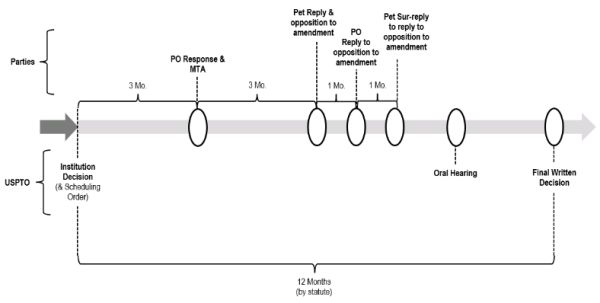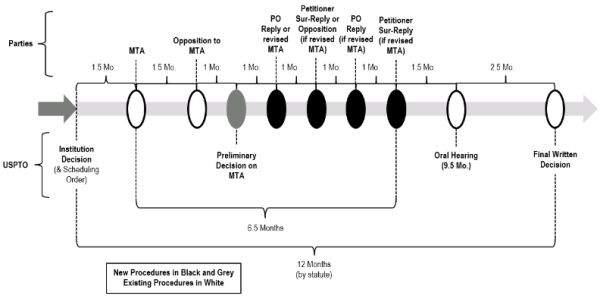The United States Patent and Trademark Office (USPTO)has proposed a pilot programme to implement changes to the current procedures for amending claims during post-grant proceedings, including inter partes reviews (IPR), post-grant reviews (PGR), and covered business method patent reviews (CBM).1 The pilot programme could go into effect as early as 14 December 2018, and applies to any post-grant proceeding instituted after thereafter.2 Consequently, this article provides an overview of this potentially imminent pilot programme, which includes a preliminary, non-binding decision on amended claims from the Patent Trial and Appeal Board (PTAB), as well as several additional opportunities for briefing and the submission of evidence, no matter which side of the "v." parties find themselves.
Current Amendment Process
Under the current procedures, a patent owner is permitted to file a motion to amend (MTA) aft er a post-grant proceeding has been instituted.3 In response, a petitioner may file an opposition. Briefing wraps up with one more reply from the patent owner. This general briefing schedule is provided in the figure below.4
Current amendment process:

Under the USPTO's Proposed Pilot Programme, What Will Change?
Preliminary Decision on a MTA
Just as before, a patent owner may file an MTA, and the petitioner may oppose. Thereaft er, according to the USPTO's proposal, the Board would provide a preliminary, non-binding decision on the likelihood of success of the proposed claim amendments.5 Specifically, the USPTO has indicated that this preliminary decision would provide information relating to whether an MTA meets statutory and regulatory requirements, as well as information relating to the patentability of proposed substitute claims.6
Two Alternate Paths
Depending on the Board's initial evaluation of the amended claims in its preliminary decision, the case will proceed according to one of two alternatives.7 The course of subsequent briefing seems to be set based on which party the Board deems to have the burden of production. Specifically, if the preliminary decision indicates that the Board is reasonably likely to deny the MTA in relation to at least one substitute claim, Alternative 1 applies.8 In contrast, if the preliminary decision indicates that the Board is reasonably likely to grant the MTA in relation to all substitute claims proposed by the patent owner, Alternative 2 applies.9 The general briefing schedule for each alternative is provided in the figure below.10
New procedures under the USPTO's pilot programme:

Alternative 1: The MTA in Jeopardy?
If the preliminary decision indicates that the Board is
reasonably likely to deny the MTA in relation to at least one
substitute claim, the patent owner is given an opportunity to
respond with evidence in support of the amended claims or to file
further amendments.11
In particular, within a designated time frame aft er receiving the preliminary decision, a patent owner may file: (1) a reply to the petitioner's opposition to the MTA and the preliminary decision; or (2) a revised MTA that revises the proposed new substitute claims and provides new arguments and/or evidence.12 If the patent owner files a reply to the petitioner's opposition to the MTA and the preliminary decision, the petitioner may file a corresponding sur-reply.13 In this case, there is a potential for two papers, i.e., the patent owner reply and the petitioner sur-reply. But, if the patent owner chooses instead to revise its MTA, the petitioner may file an opposition to that revised MTA, the patent owner may file a reply to that opposition, and the petitioner may file a sur-reply, each within the designated time frame.14
The USPTO has indicated that a revised MTA should explain why the revised substitute claims meet statutory and regulatory requirements for an MTA, as well as present arguments relevant to the patentability of the revised substitute claims.15 Additionally, according to the USPTO, a revised MTA is limited to amendments, arguments, and/or evidence that responds to issues raised in the preliminary decision and may not include issues not raised in the preliminary decision or the petitioner's opposition to the MTA.16
Alternative 2: MTA in Good Shape?
If the preliminary decision indicates that the Board is reasonably
likely to grant the MTA in relation to all substitute claims
proposed by the patent owner, the petitioner will be given an
opportunity to respond with evidence in an attempt to prove
unpatentability of the amended claims.17
In particular, in response to the preliminary decision, the petitioner may file a reply to the preliminary decision, and the patent owner may file a sur-reply in response within the designated time frame.18
The USPTO has indicated that the petitioner reply may be accompanied by new evidence that responds to new issues raised in the preliminary decision.19 But the petitioner may not raise a new argument of unpatentability that it did not raise in its original opposition to the MTA.20 Also, according to the USPTO, the patent owner sur-reply may only respond to arguments made in reply briefs, comment on reply declaration testimony, and/or point to cross-examination testimony.21
Other Considerations and Conclusion
In addition to proposing changes to the briefing schedule, the USPTO has also indicated that the Board may, in certain circumstances, use its discretion to solicit assistance from a patent examiner in the absence of a petitioner opposition to an MTA.22 According to the USPTO, if the petitioner ceases to participate altogether in an AIA trial in which the patent owner files a MTA, and the Board nevertheless proceeds with the trial thereafter, the Board may get assistance from an examiner for assessment of statutory and regulatory requirements, or patentability of proposed substitute claims.23
Additionally, the USPTO is also requesting comments from the public regarding whether it should engage in rule making to allocate the burden of persuasion as set forth by the recent PTAB decision in Western Digital.24 Specifically, the USPTO indicates that it would like public comment on the circumstances in which the Board itself may justify findings of unpatentability.25 The USPTO suggests that the circumstances may include when the petitioner has ceased to participate in the proceeding or when the petitioner remains in the proceeding but chooses not to oppose the MTA.26
Because this proposed pilot programme may be right around the corner, parties and potential parties to post-grant proceedings may want to proactively consider the potential implications of this programme — not the least of which is increased time and expense to account for the additional briefing and expert involvement that the changes allow.
Footnotes
1. Request for Comments on Motion To Amend Practice and Procedures in Trial Proceedings under the America Invents Act Before the Patent Trial and Appeal Board, Docket No. PT-P-201-0062, https://federalregister.gov/d/2018-23187.
2. Id. at 21.
3. See Trial Practice Guide Update (August 2018)
https://www.uspto.gov/sites/default/files/documents/2018_Revised_Trial_Practice_
Guide.pdf, p. 14.
4. See Trial Practice Guide Update (August 2018), Due Date Appendix, https://www.uspto.gov/sites/default/files/documents/2018_Revised_Trial_Practice_Guide.pdf, p. 30.
5. See Request for Comments on Motion To Amend Practice and Procedures in Trial Proceedings Under the America Invents Act Before the Patent Trial and Appeal Board, https://federalregister.gov-/d/2018-23187, pp. 15-16.
6. Id.
7. Id. at 16-19.
8. Id. at 16-18.
9. Id. at 18.
10. Id. at 28.
11. Id. at 16.
12. Id.
13. Id. at 17
14. Id.
15. Id. at 16.
16. Id. at 16-17.
17. Id. at 18.
18. Id.
19. Id.
20. Id.
21. Id. at 19.
22. Id. at 19.
23. Id. at 19-20.
24. Id. at 22; Western Digital Corp. v SPEX Techs.,Inc., Case IPR2018-00082 (25 April 2018).
25. "Board itself also may justify any finding of
unpatentability by reference to evidence of record in the
proceeding." Western Digital
Order 4.
26. See Request for Comments on Motion To Amend Practice and Procedures in Trial Proceedings Under the America Invents Act Before the Patent Trial and Appeal Board, https://federalregister.gov/d/2018-23187, pp. 22-23.
The content of this article is intended to provide a general guide to the subject matter. Specialist advice should be sought about your specific circumstances.

